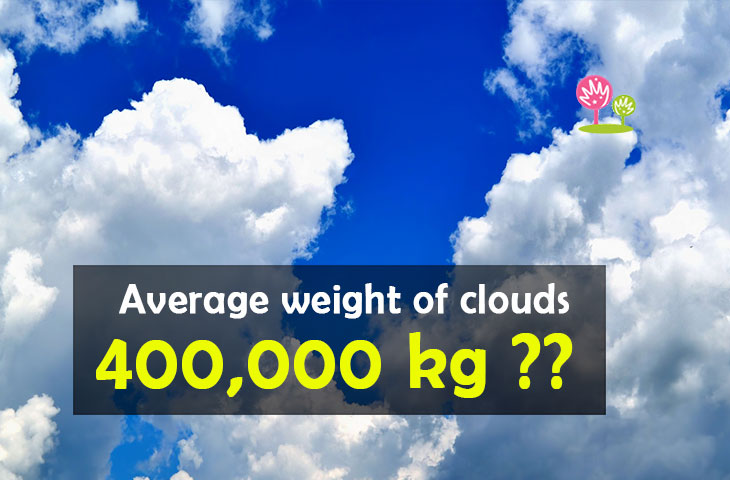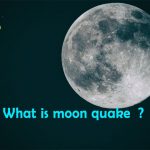Know about weight of clouds

Clouds are one of the amazing factor in nature. We always look on the clouds with great fun and curiosity. Some times we feel that clouds are saying something about us or conveying something to us through the form of different shapes. It may be in the shape of a rabbit or dog. Sounds interesting right ???? There are so many other mind blowing factors about Clouds..lets see..
What are Clouds ?
In meteorology, a cloud is an aerosol consisting of a visible mass of minute liquid droplets, frozen crystals, or other particles suspended in the atmosphere of a planetary body or similar space.[1] Water or various other chemicals may compose the droplets and crystals. On Earth, clouds are formed as a result of saturation of the air when it is cooled to its dew point, or when it gains sufficient moisture (usually in the form of water vapor) from an adjacent source to raise the dew point to the ambient temperature.
They are seen in the Earth’s homosphere, which includes the troposphere, stratosphere, and mesosphere. Nephology is the science of clouds, which is undertaken in the cloud physics branch of meteorology.
In two ways Clouds get their names. One way is by where they are found in the sky. Some clouds are high up in the sky. Low clouds form closer to Earth’s surface. In fact, low clouds can even touch the ground. These clouds are called fog. Middle clouds are found between low and high clouds.
Another way clouds are named is by their shape. Cirrus clouds are high clouds. They look like feathers. Cumulus clouds are middle clouds. These clouds look like giant cotton balls in the sky. Stratus clouds are low clouds. They cover the sky like bed sheets.
How rain is formed ?
Most of the water in clouds is in very small droplets. The droplets are so light they float in the air. Sometimes those droplets join with other droplets. Then they turn into larger drops. When that happens, gravity causes them to fall to Earth. We call the falling water drops “rain.” When the air is colder, the water may form snowflakes instead. Freezing rain, sleet or even hail can fall from clouds.
Amazing facts about Clouds
A cloud droplet is just 0.02mm in diameter – that’s five times smaller than the thickness of a piece of paper – yet these droplets condense together to form clouds up to 14 miles high!
High-level clouds start at 20,000ft and are made up of ice crystals – whereas clouds lower down are made up of water droplets.
Arcus clouds look a little like a tidal wave in the sky, and are also known as shelf and roll clouds. They’re often spotted beneath powerful storms, and form when warm air from the ground is pushed up by the cold air exiting from the storm cloud in the downdraft. These spinning cylinders herald the coming of the storm front
There are many factors that will determine the exact amount of water vapour a cloud holds (e.g. temperature, altitude, pressure etc.) we can work with an average of about 5 g of water per cubic metre of cloud.
This means an average size cumulonimbus would weight about 400,000 kg, roughly the same weight as an Airbus A380.
The title of highest cloud goes to the rare but beautiful but noctilucent cloud. They hover at around 60,000 m (200,000 feet) and are too faint to be seen in daylight.
They become visible during twilight when sunlight from below the horizon illuminates them to reveal their faint ghostly outlines
The earth’s atmosphere is a very cloudy place. NASA’s Earth Observatory estimates that at any given time, around 67% of Earth’s surface is covered by cloud.
Based on observatory data between 2002 and 2015, NASA’s Aqua Satellite image (below) clearly shows three zones which are the cloudiest, over the mid-latitudes and over the equator.
These zones are created by the interaction of large cells of air which are part of the earth’s global circulation patterns.
Clouds are mostly white in colour. The reason clouds are white and the sky is blue is all to do with the colour spectrum of light. Light from the sun starts out white but becomes scattered by particles in the sky. Atmospheric particles in the sky scatter away blue light more than other colours which gives the sky its blue appearance.
But as light passes through a cloud it interacts with larger water droplets which scatter all colours of the spectrum of light almost equally. This means that the sunlight continues to remain white making the clouds appear white against the background of a blue sky.
• Clouds can contain millions of tons of water.
• There are a range of different types of clouds, the main types include stratus, cumulus and cirrus.
• Stratus clouds are flat and featureless, appearing as layered sheets.
• Cumulus clouds are puffy, like cotton floating in the sky.
• Cirrus clouds are thin and wispy, appearing high in the sky.
• There are many variations of these 3 main cloud types including stratocumulus, altostratus, altocumulus, cirrostratus and cirrocumulus.
• Fog is stratus type of cloud that appears very close to the ground.
• Other planets in our Solar System have clouds. Venus has thick clouds of sulfur-dioxide
• Clouds can contain millions of tons of water.
• There are a range of different types of clouds, the main types include stratus, cumulus and cirrus.
• High-level clouds start at 20,000ft and are made up of ice crystals – whereas clouds lower down are made up of water droplets.
• Stratus clouds are flat and featureless, appearing as layered sheets.
• Green clouds often mean a tornado is coming.
• Cumulus clouds are puffy, like cotton floating in the sky.
• An average cloud weighs 216 thousand pounds. An average storm cloud weighs 105.8 million pounds.
• Cirrus clouds are thin and wispy, appearing high in the sky.
• NASA’s Phoenix Mars Lander has detected snow falling from Martian clouds.
• There are many variations of these 3 main cloud types including stratocumulus, altostratus, altocumulus, cirrostratus and cirrocumulus.
• There is an official international Cloud Committee
• Fog is stratus type of cloud that appears very close to the ground.
















